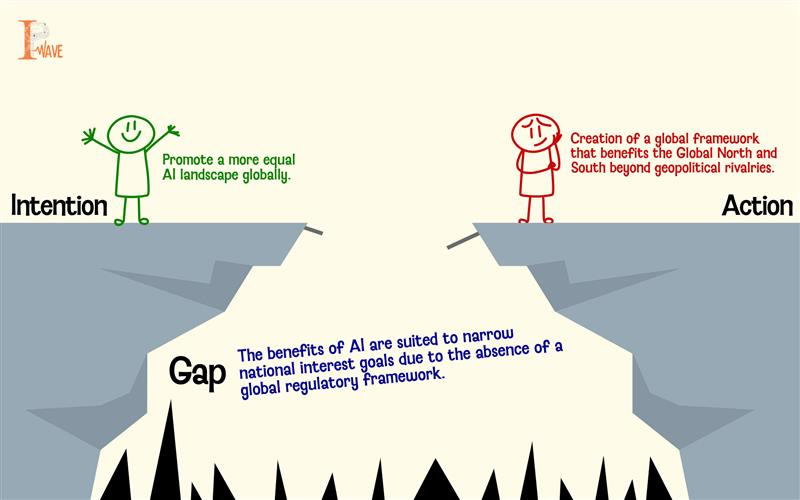The Geopolitics of Artificial Intelligence: A Dual-Edged Sword
For those who believe that Artificial Intelligence is simply about technological advancement and not global power dynamics, they need to think again. As the world races to extract the benefits of the transformative potential of Artificial Intelligence, the geopolitical competition that accompanies it cannot go unmissed. This competition is usually couched in terms of innovation, national security and international cooperation. However, the absence of any sort of comprehensive governance framework for AI is a significant threat to the future, both in terms of stability and equality.
Transformative AI is concerning because of its dual-use nature. Given that it has become a strategic asset for most nations, resulting in a frenzied geopolitical innovation race – the Global North has a clear advantage than the Global South.
In the 21st century, the pursuit for AI is not simply about science and technology or economic prosperity but rather national security. Central to the use of AI is its application in military affairs, intelligence gathering and enhancing one’s cyber capacities means generating more offensive and defensive strength. Thus, those who control the critical inputs of AI like computing power, talent, data and infrastructure are those who control the entire landscape. They use export controls, investment bans and other restrictions to enhance domestic capacities.
The Dual-Use of AI: National Security Game Changer
AI is not simply a civilian tool – it has become imperative in the national security calculus of most nations primarily because of its military application. AI is being used by most militaries in battlefield computation, defensive cyber operations and the creation of autonomous weapons systems. Large data sets are scanned easily to create stronger links between sensors and shooters, reduce decision making time and enhance troop deployment. AI systems designed to detect diseases could easily be repurposed to do biological warfare research. The need to preserve their technological edge cannot be seen more blatantly than between US and China.
China has devised strategies like “Made in China 2025” and its Next Generation AI Developoment Plan seek to create technological self-sufficiency and application across sectors. It has developed autonomous weaponry systems like the Wing Loong and CH-7 – both advanced drone systems. China has integrated AI into its cyberwar doctrine and does not shy away from cyberespionage and information warfare. It has created DeepSeek as an alternate to US models like Gemini, ChatGPT and OpenAI.
The US on the other hand has displayed incredible progress in creating unmanned aerial vehicles (UAVs) like the V-BAT and Nova developed with US companies like Andruil and Shield AI. The CIA and the NSA are using AI for intelligence gathering and threat detection including Open Source Intelligence (OSINT). Project Maven is a well-known US project used by the military in intelligence, surveillance and reconnaissance. Similarly, it has developed platforms like the F-35 Lightning II fighters to predict equipment failure and proactive maintenance aided by advanced artificial intelligence developments. Systems like Joint All-Domain Command and Control (JADC2) and Aegis Combat system have revolutionised AI application in the armed forces.
While there is no refuting the positives of AI including scientific breakthroughs, economic growth and better health systems, its increased application in military capacities is concerning. This logic has become central to national security policy making – governments are challenged between promoting open access to AI technology and creating a more open global AI landscape that promotes diffusion. A controlled AI landscape means strategic containment and an open landscape could warrant military exploitation.

IP and AI: What Happens?
In addition to this, the application of exiting IP laws to AI-generated creations further complicates the geopolitical struggle. Designed to be a framework to protect human creativity, IP laws are leveraged by countries to shield domestic AI industries and to use them as bargaining chips in the international world. Ownership and copyright debates about AI generated content remains hotly debated and largely unanswered. The divergent legal stances of various countries further disrupt the system and enforcement becomes highly contested.
The Lack of Global Governance
The intermesh of these issues is exacerbated by the lack of a global governing framework in place that regulates AI application and development. While AI has become international in applications, governance frameworks are codified in national frameworks. There are no agreed upon laws, norms or principles that are can be enforced for responsible deployment and development of artificial intelligence, especially its dual-use applications. This further extends to sharing the benefits of artificial intelligence as well. Export-controlled regimes are created by rich western nations leaving the Global South as a passive recipient of AI technology rather than a co-creator.
The US-China AI completion is an example of the deepening of this divide – smaller nations are forced to align with one of the two nations when it comes to critical capacities like AI. The technology is used to bargain for gains in the anarchic international order rather than being shared for common progress.
China’s Digitial Silk Road initiative is how it exports its AI technologies including cloud computing, data centres, and smart city tech. This adds to the geopolitical influence that Beijing collects. Similarly, the United States has launched an aggressive campaign to limit growing Chinese influence in AI. The bans of semiconductors and AI chips have been used to slow China’s progress on the matter and to restrict access to essential hardware. It has leveraged relationships with countries like Japan and the Netherlands to enforce these restrictions and control the global supply chain. The battle between the two giants has resulted in a technological landscape that is shrouded in geopolitical rivalries rather than progress and innovation at heart.
Moreover, the politics of existing IP frameworks are manipulated to suit national interests as well. Europe’s emphasis on data privacy is in direct conflict with the US model of market-driven innovation. The result is the creation of a dangerous void where ethics and security are absent when it comes to AI application control.
The lack of a comprehensive framework could result in the benefits of AI being condensed in the hands of a few nations rather than being available for all. The intense bilateral competition between the US and China could marginalise other countries including the creation of a multilateral system that could create the foundational grounds for AI governance.
Conclusion
The development of AI technology and its application including military purposes cannot be seen a zero-sum game. A genuinely collaborative global framework is the need of the hour to ensure that the significant investments and progress made in AI could be beneficial to all. Regulatory measure to prevent monopolies and international bullying should be explored to create a more effective AI regime. We must not forget the larger ethos of humanity in view of narrow man-made boundaries.


